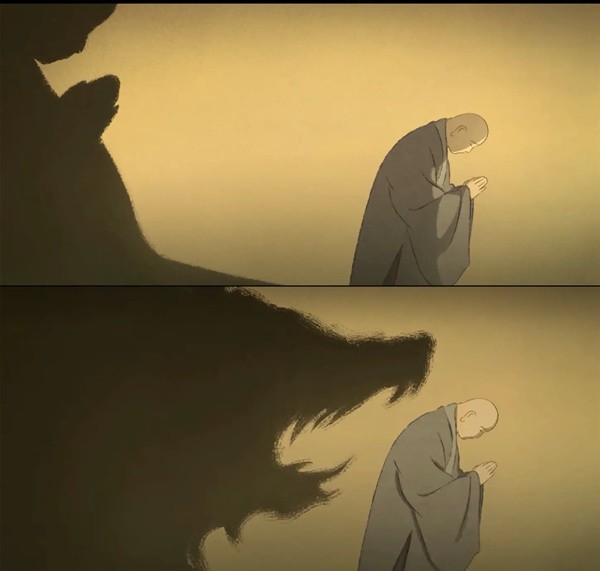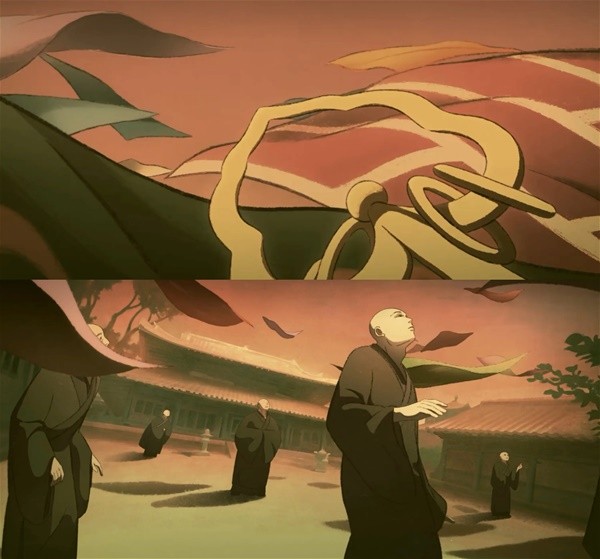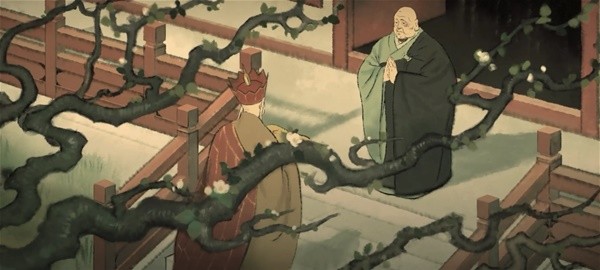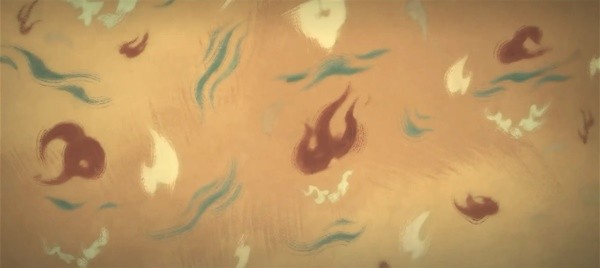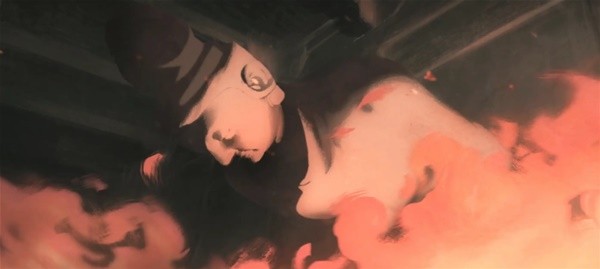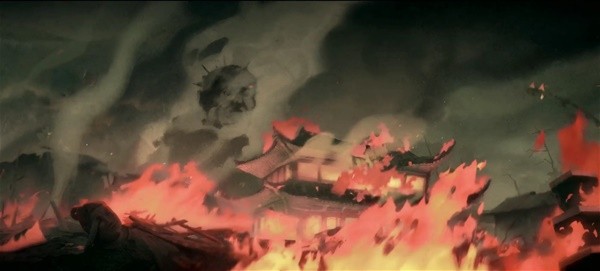“Black Myth Wukong” each chapter ends with an animation, want to understand the first time the end of the animation of the specific meaning of the small partners please see below by “Daybreaker Chu Xuan” for everyone to bring the “Black Myth Wukong” the first back to the fire shine black cloud animation analysis, I hope you can enjoy.
As the animation at the end of the first chapter of the game, its content is basically the same as the “Journey to the West” in the burning of the Guanyin Zen garden related plot, but, in order to enrich the characters and highlight the “greed” theme, “Fire Shine Black Cloud” animation using more detailed portrayal of the story will be the story of the life of Jin Chi Elder in a short four minutes to carry on the The story of Elder Jin Ji’s life is summarized in just four minutes, and there is a lot of thoughtprovoking philosophical discourse in it. So how does a fiveminute animation with almost no lines combine philosophy and storytelling? We will look for the answer from the animation.
The first part of the animation: the little golden pool to catch the golden toad, the moral of this paragraph I believe many people have carried out interpretation.
In short, the toad represents wealth, and the capture of the golden toad by the small golden pool is itself a metaphor for his pursuit of money and fame, and ultimately he cannot pursue it, but instead encounters the Black Bear Spirit, with a metaphor of gradually getting lost in greed.
Let’s take a look at the patterns on this toad, and aside from the coinlike pattern representing money, the most central and prominent pattern on this toad is what appears to be an unclosed copper penny – which is really more of a woodchuck.
The wooden fish, as a tool for chanting sutras and reciting the Buddha’s name, represents Buddhist cultivation in this context. Thus it can also be deduced that Little Jinchi’s purpose in chasing after the golden toad is in fact also to cultivate Buddhism and study the Way – at least in Jinchi’s view, he is indeed chasing after the fulfillment of his cultivation, whereas his means are consistent with those of chasing after mundane money, fame, and fortune.
The toad jumps into the hand of the fallen corpse. Here it was actually hard to distinguish when looking at it for the first time, because the hand was similar in color to the surroundings, and the outline did not stand out, it was completely hidden in the environment, rather like a feeling that human life was like grass, at the same time, there were many copper coins scattered next to this hand, if Jin Chi was purely pursuing wealth at this time, he should have taken away these copper coins, however he chose to continue to chase the toad, which side by side confirms that what Jin Chi was longing for was in fact Cultivation achievement, rather than mere wealth.
At the same time, when I watched the movie repeatedly, I felt that here, Xiao Jinchi chased the golden toad but was unable to do so, just as Elder Jinchi chased the realm of the Golden Cicada but was unable to do so, which may be an echo of the resonance between the golden toad and the Golden Cicada, and at the same time, this kind of “seeking but not being able to do so” is also found throughout Jinchi’s life. This “seeking but not being able to” also runs through Jin Chi’s life.
Next, the direction of the tree branches in the image of Little Jinchi advancing through the woods is actually where Toad and Jinchi are headed, with a couple of back switches of Little Jinchi and the branches always facing the center of the frame, and when the scene comes to the overturned car, the branches are completely surrounding and pointing at the image of Jinchi and the black bear, a very nice visual guide.
The black bear appeared in this part of the animation, first of all, the bear’s figure and overturned to the car to combine, visually hide the existence of the bear, for the subsequent black bear to get up to pave the way, at the same time, here the picture also indirectly explains the black bear later gripped to the gold pool of the money is where the money came from – car next to the row of corpses collapsed, it must be that the car was once the owner of the car.
In the meeting between Jinchi and the black bear, there is a huge disparity in proportion between the two, and the most obvious characteristic of the black bear spirit is the pair of red eyes, which is also a figurative manifestation of the socalled “eyes to see joy”.
Here we should also mention the design of the black bear’s image, the black bear’s color scheme is mainly black, and the lines constituting its silhouette are based on blue and green, together with the red eyes, which not only highlights the vicious image of the black bear, but at the same time, the colors of the black bear’s body will also be used in the performance of the subsequent episodes, and the red and black that represent its image have become the representative colors of “greed” – which is also known as “greed” – and the most obvious of its characteristics is the pair of red eyes. “However, from the perspective of animation color analysis, black and white are generally not considered colors for analysis, so we will focus on the red color in the animation.
At this point, the greed represented by the black bear in the image is overwhelming and difficult for the young Jinchi to resist at the time, so Jinchi’s action is to subconsciously close his eyes and fold his arms.
And next, the scene begins to warm up after Xiao Jinchi opens his eyes and sees the money bag in the black bear’s mouth, and the yellow glow seems to be emanating from the money bag, but according to the subsequent scenes, the glow here actually comes from the Guanyin Zen Garden. Thus, there is a correspondence here: the money bag and the Guanyin Zen Center, which likewise implies that the practice of Buddhism and the pursuit of wealth are in a position of reciprocity here.
There’s another detail in the picture here; when the scene returns to Jin Chi and the Black Bear sitting opposite each other, with the Guanyin Zen Garden in the background showing, it’s the Black Bear spirit that looks in the direction of the Zen Garden first, followed by the little Jin Chi.
We now know that the Black Bear Spirit is the figurative embodiment of greed, and Jin Chi as the character manipulated by greed, and the fact that the Black Bear looks first toward the Zen garden Jin Chi and then follows his gaze has the implication that Jin Chi is henceforth driven by a massive greed.
The next section shows Jin Chi practicing in the Guanyin Zen garden, and in this section, the image remains warm throughout, with yellow taking up the majority of the scene, and in this section, Jin Chi seems to be portrayed in a positive light as well.
In the first scene beginning with Xiao Jinchi’s initial entry into the Guanyin Zen Center, Xiao Jinchi’s head is bowed and his eyes are closed, and his expression seems to be a bit rushed before he opens his eyes and looks around.
According to the title of the animation, “Seeing,” and the theme of the chapter, “Eyes Seeing Joy,” Jin Chi’s opening and closing of his eyes actually has a certain meaning, which is also reflected in the subsequent images.
Here, Xiao Jinchi looks up and opens his eyes to see monks all around him wearing all different kinds of robes, an outward sign of a monk’s cultivation status.
In the picture, the color of the monks’ robes is dark green, dark red, and a dark brown that is close to black, giving the impression of heaviness and solemnity, while Xiao Jinchi is wearing light green clothes, which appear light and outstanding in the contrast of the whole picture, and this shows Xiao Jinchi’s inexperience in the Zen monastery and his shallow cultivation.
And after a stumbling transition, the picture gives a closeup of the young Jinchi’s face, hands folded, head first bowed, then eyes closed.
What does this image imply here? First of all, compositionally, the image of young Jin Chi’s closed eyes corresponds to the image of young Jin Chi’s timidly opening his eyes when he first enters the Zen center, and what he sees with his eyes are monks in gorgeous robes, which is the source of his greed – so Jin Chi’s “closed eyes” are saying that he is putting an end to his desire? So Jin Ji’s “closing his eyes” means that he has eliminated his desires?
Apparently not.
The closing of Jin Chi’s eyes here doesn’t mean that Jin Chi rejects the desire, because in the next image, the figure of Jin Chi with his hands folded and eyes closed chanting Buddha takes the form of a black bear and devours Jin Chi.
In this switching screen of Jin Ji’s image transformation, you can see that from the small Jin Ji to the young Jin Ji, although the monk’s robe is still light green, but due to the difference in light and shadow processing, the young Jin Ji’s half of his body is in the shadows, and in the shadows the color of the monk’s robe is biased towards dark green, which creates a kind of “seemingly different”, “seeking but not being able to” feeling. “Although he still aspires to attain perfection, the splendor of his appearance makes him long for it, and Jin Ji in the shadows also aspires to the “darkcolored robes” in his heart.
The bowing of the head and closing of the eyes here also contrasts with the subconscious closing of the eyes and bowing of the head of Little Jinchi when he first meets the Black Bear Spirit, which in this case should be a yielding to desire, his acquiescence, and his obedience.
From not knowing how to resist in the face of desire, to the desire to face the desire to choose to submit to the desire of the transformation, and this closeup of the closed eyes is quite a kind of coverup – he thinks that since he will be compelled by desire if he opens his eyes to see, that greed must be obtained by the eyes to see, so then he will close his eyes, and close his eyes and then succumb to the greed of the driving force of the selfparalyzing He thought that it would not be his fault.
In the next scene, Jinchi changes his clothes, stands out from the monks, and quickly, with his head thrown back, ascends the steps.
Here, Jin Chi is no longer portrayed in his initial plain monk’s garb, and is distinguished from his character only by the two dots around his mouth, but at the same time, the language of the image is able to tell us visually that the person quickly ascending the steps is Jin Chi.
The first thing is the character’s clothing, which is different from any of the previous treatments; this time, the red robe that Jin Ji is wearing stands out in terms of brightness, especially against the yellow and green background of the image, and such a bright red color is very striking.
Secondly, Jin Chi also moves faster than the monk characters around him in terms of amplitude and rate, and although the characters in the scene are moving forward, Jin Chi is the only one who moves forward faster, while at the same time, Jin Chi has another moment where he goes from closing his eyes to opening them, in contrast to the other monks around him who keep their eyes closed the whole time.
While the monks chanting with their eyes closed are letting go of their desires, Jin Chi’s sprinting forward with his eyes open is utilizing his desires to make constant progress. By this time Jin Chi had gradually learned to drive his greed, the greed for cultivation, the greed for knowledge, and likewise, the greed for higher status, and greed did drive him forward.
The next scene shows Jin Chi’s footsteps moving forward, followed by the addition of the Zen staff, which itself is something that can only be held by a high monk and a great power, and as Jin Chi walks to the heights of the dais, the shot here then clearly accounts for the character’s perspective of wielding power through the frame.
Jin Chi then turned back around, with no other monks behind him, symbolizing that he had surpassed most of the people who practiced and gained a position of virtue.
At the same time, the red robe on his body has changed from a halfbody cloak to a fullbody cloak, which represents the status of nobility, and at the same time, wearing the red robe also means that the character has absolute control over the “greedy desire”.
Jinchi turns around, and there’s a lot of very fine processing detail in this animation.
In this part of the closeup of Jin Chi’s turning surplice, the dark red body of the surplice flutters in the wind in the background, and the pattern on the surplice is not completely static, but changes as the surplice fluttersthe plum blossoms (?) on the upper half of the surplice, and the flower petals on the upper half of the surplice, and the flower petals on the upper half of the surplice, are not completely static. branches, picking up on the fluttering petals in the previous image, the camera pushes further down, and the black bear that can be seen at this point is pure black except for the lines showing the silhouette, and the eye area is the same dark red color as the background, and at the time of the black bear’s appearance, its eyes are completely hidden from the image as a whole. And when the camera continues to pan down and the bear appears in the picture as a whole, his red eyes suddenly light up in a bright red with high contrast, while the plum blossom on the branch and the white lotus (?) flower next to the bear bloom. bloom, the blossoming of the flowers implies wealth and prosperity, and at the same time, the image gives the viewer a greater sense of impact and aggression, so as to feel Jin Chi’s greed gradually expanding and spiraling out of control.
The animation of the pattern on the robe is very subtle, from the point of view of expression, the animator can actually do without this dynamic viewers can understand the meaning of the black bear pattern on the robe, but it is because of this dynamic performance, completely bring the feeling of “greed” to life, especially when the black bear’s eyes are red and bright, and immediately bring out the sense of danger and aggression brought about by greed, it is a very powerful performance. Especially when the red light of the black bear’s eyes flared up, it immediately conveyed the sense of danger and aggression that greed brings, which was a very powerful performance.
Next, the camera travels through the gate in the courtyard wall of the temple – note that from here, the original earthy sky in the background has taken on more of a red color, and the red is still in an overwhelming position; greed is sweeping all around the place here, unhindered.
Jin Ji is standing in the middle of the monks, waving his staff and waving his hand in the wind. At the same time, Jin Ji’s entire face is in the shadows, except for his eyes, which are like the eyes of a black bear emitting a red light, which is different from the weak and cowardly face of greed before, and the unwillingness to begin to take advantage of the desire to be devoured, and which means that Jin Ji has completely merged with the “Greed” and that he has become the essence of the Greed.
Then, the Zen staff shook and the surplice flew in the sky. The monks looked up, the Buddha was furious, while Jin Chi stood in the center of the swirl of flying robes, wearing a smile on his face.
A small detail, the picture, the robe flying in the sky, there are monks are jumping to try to catch the robe in the sky, this also represents, Jin Chi this kind of emphasis on the external gold clothing rather than to dive into the practice of Buddhism practice has apparently been a lot of other monks fans, the next picture, is the angry eyes of the Buddha, at this time, the concept of the Jin Chi practice has departed from the original intention of the Buddhists.
At this point, let’s stop and rethink what Jin Chi means by “greed”.
From the point of view of the meaning, the toad and the robe seem to be secular valuables, but the wooden fish pattern on the toad and the robe represent figurative cultivation. From Jin Chi’s point of view, what he wants to chase after is actually the refinement in cultivation, he wants to become a high monk and cultivate the Great Way – while chasing after the toad and collecting the robes are secular He thought he was practicing Buddhism, but in fact he still could not let go of fame and fortune, and only valued superficial glamor. When one’s eyes see joy, one closes one’s eyes, thinking that by closing one’s eyes one is keeping away from the entanglement of desires, but in reality one closes one’s eyes to obey the drive of desires.
The animation comes to the moment when the Tang Monk and his party arrive at the Guanyin Zen Center.
After the black screen, the screen came to the distant view of the Zen garden, the main color of the screen also changed from the previous surging red to a calm and heavy dark green, the distant path, the Tang Monk and the Wukong are moving towards the Zen garden.
Monk Tang meets with Jin Chi.
The branches of the plum blossoms in the picture radiate out as if from the direction from which the Tang Monk came, the rugged branches from left to right, representing aggression and pressure, at the same time, the red color in the picture increases once again, whether it’s the Tang Monk’s attire, the red robes and tiara or the red thresholds and fences in the environment, the red color continues to represent desire here, and then when you look at Jin Chi, you’ll see that he’s dressed in a light green + dark green outfit instead, extremely plain – seems to imply that Jin Chi has become enlightened and has let go of the exquisiteness and splendor of the outside?
In fact, in the original Journey to the West, there was a special depiction of Jin Chi’s image when he appeared, and you can see that Jin Chi was also dressed very gorgeously at that time, so why did the animation make changes?
I personally have two interpretations here:
The first one is that Jin Chi has seen too many robes and Buddhist tools in his 200 years of cultivation, and he has reached the ultimate of external “Buddhism”, so it is reasonable to say that he can’t pursue more, therefore, Jin Chi can even go back to the basics and begin to control his own desires, and truly cultivate the heart of Buddhism, but the appearance of the Tang Monk breaks this situation. This situation is not only because of the lanthanum robe – the Tang Monk’s origin (the reincarnation of the Golden Cicada), age, status (the high priest of the Great Tang Dynasty), and understanding of Buddhism are all above Jin Chi, and now entrusted by the bodhisattva to have the opportunity to fetch the scriptures and cultivate into the right fruits, so Jin Chi is even more compared to it.
The lanthanum robe is only an external manifestation for the Tang Monk, who is still the Tang Monk without the robe, while in Jin Ji’s view, after living for more than two hundred years, he doesn’t know whether he can still pursue the socalled fruition of the Buddha’s teachings, and the lanthanum robe becomes the symbol of the “fruitfulness of cultivation”, which once again makes him fall into the vortex of greed.
The second is that, compared to the Tang monk’s cultivation and his jinlanthanum robe, all of Jin Chi’s “cultivation” seems dull and drab, so Jin Chi is painted in an old, dark green, while the Tang monk is painted in a brilliant red, and the difference between the two is explained by the colors.
Back in the scene, the Tang Monk hands the robe to Jin Chi, and the scene gives a closeup of the lanthanum robe.
In the original Journey to the West, there is a description of the appearance of the lanthanum robe, with the line “A thousand ingenious pearls fall, ten thousand rare Buddhist treasures are saved” being enough to illustrate the splendor of the robe. The animation of the robe, without using too complicated carving, golden yellow as the background, and then by the red, blue, bright yellow pattern composed of “wind, fire, thunder three plagues” pattern (checked, here ‘wind, fire and thunder three plagues’ refers to in the Journey to the West in particular) The most prominent pattern is the red pattern representing the plague of “fire”, which not only foreshadows the later episode of the burning of the Zen garden, but also continues to emphasize the element of “greed”. “This not only foreshadows the subsequent burning of the temple, but also continues to emphasize the element of greed.
Next, Jin Chi returns to the house alone with the robe to view it.
Here you will notice that Jin Chi’s clothing has changed again – he is once again wearing a light green monk’s robe similar to the one worn by Jin Chi, giving the audience a sense of returning to the beginning. Jin Chi sees the lanthanum robe as Jin Chi did the first time he saw the black bear, and once again he is confronted with irresistible, uncontrollable desires.
Jin Ji examines the robe in his hands, the whole environment you can see, the lights in the room are dimmed, the only real source of light is actually the robe, lighting from the bottom up to illuminate Jin Ji’s face, and cast shadows on the wall; followed by closeups of Jin Ji’s face, the camera tilted up, Jin Ji’s face looks extraordinarily old and ugly, especially downward corner of the eye and the pupils of the pupils are very small, will give a person a kind of impish peepers, the eyes of the eyes of the eyes is also red, but different from the previous image of imaginative red, here it is like a long time staring at the eyes. There’s another detail here: the whites of Jin Ji’s eyes are actually red, but unlike the visualized red in the previous image, Jin Ji’s eyes look like they’ve been staring at an object for a long time and have become bloodshot – he’s “redeyed”! He was too redeyed.
Returning to the center shot of Jin Chi holding the robe, his shadow begins to turn over until he turns into a black bear.
We look closely at the dynamics of the shadow, first of all, the shadow is out of the human form, then the shadow of the head of the black bear, there is a clear headuplike movement, then the shadow continues to surge and change, the shape is more like a flame, “shadow – black bear – flame” step by step transformation, is the greed gradually uncontrollable desire of the visualization of the manifestation.
At the same time, you will notice that Jin Ji’s own form changes in this section, from smiling and admiring, to gradually bringing the robe closer to his face, and then gradually lowering his own head to look at it, at which point his expression is no longer one of laughter, but more akin to “indignation”, and the shadow behind him completely changes into a black bear.
Although greed is terrible, but what is even more terrible is that greed is not satisfied.
Thus, only destruction will follow.
From here on, the picture has begun to make a sense of anticipation for the viewer in front of what is to come.
Then Jin Ji shakes the robe, and the main body of the image returns to the bright red flame pattern on the robe, which appears in the center of the image and at the same time has a completely different, more active motion than the background of the robe, making it feel like flames are jumping around – and here is where the strength of the animation over other forms is also highlighted: you’ll notice that the red flame pattern not only keeps jumping in the center of the image, but also keeps jumping in the center of the image, which is the same as the red flame pattern in the background. pattern doesn’t just keep jumping in the center of the frame.
And as we continue to watch, and the scene pushes into the distance, with the action of Jin Chi about to put on his robe, instead of getting smaller according to perspective (and of course, the size of the robe is exaggerated here), these red flames become larger and more prominent – the fire of the heart is hard to extinguish, and when greed starts to burn, it only begins to magnify infinitely. This is the kind of exaggeration and symbolism that only animation can do.
Next, Jin Ji puts on the robe, he bends his body completely, his hand in front of his chest seems to be clutching the robe, his whole form is actually rather stooped. But then he has that very contented smile on his face, and here, on the one hand, his desire for the surplice is reflected, but on the other hand, there is also the feeling of being wrapped up and swallowed up by his desire and succumbing to it.
Jin Ji has put on the robe, and he is satisfied, feeling that he can finally “close his eyes”. However–
The robe leaves Jin Chi as if being dragged by the wind, and Jin Chi panics and reaches for it. There’s actually a shift here as well, where we get to see the form of Jin Chi’s character as he drops to the ground, looking extra bloated – an intentional design.
Because if you go back and look at all the characters’ images throughout the animation, including Jin Chi’s image before he puts on the robe, the whole line is quite round and smooth, only after he falls, the form given to him becomes bloated, with the curves colliding with each other, giving an incongruous, clumsy feeling, with a small head but a bloated body, with all four limbs on the ground, the
What does this prostrate form resemble more? It is like a toad–and is echoing the very beginning, the toad that Koganechi chased, that was also the source of all his lust and greed, and here the closing of the loop is completed.
The robe began to flutter around Jin Ji, it is obvious to see that the original robe on the “three plagues” pattern detached from the robe with the dance, gradually engulfed Jin Ji. From here on, Jin Ji’s original somewhat benevolent image has completely disappeared, and his head has turned into a gourdlike pile of flab on the top and the bottom, including his outstretched hand with sharp nails, which also further reveals the character’s inner ugliness.
In the next scene, the robes are scattered into many pieces, fluttering around Jin Ji; this scene corresponds to the previous one in which Jin Ji waved his staff to invoke the robesthe difference is that when Jin Ji waved his staff, the robes of various colors were dispersed in a clockwise direction with Jin Ji at the center, and he was complacent, his power at its peak; now, the robes have changed into flames of the brocade lanthanum surplice was encircling counterclockwise with Jin Ji as the center, at this time he was horrified and completely lost his position.
The surplice swallowed the golden pool into a dragon scroll, and the color changed from the original golden color of the surplice to red + black. As the surplice rolls, the image completely changes to a color that consists of red and black intertwined with greed, the color scheme of the Black Bear Spirit, and further back, the color of the Guanyin Zen Garden, which is engulfed in red flames at night.
Picture the golden pool with the outward appearance of the tumbling black bear, the red eyes, greed has united these two, the black flames, the red flames, and all is headed for destruction. The black and red flames then complete the transition, and the scene is given to the Buddha in the room, the black and red “robe” sweeping by like the wind.
Then, the statue of Buddha collapses, the black wind made of the robe sweeps through, and the beams of the room catch fire and collapse. In this paragraph, the collapse of the statue of Buddha means that the way Jin Chi has been paralyzing himself or the way he thought he was practicing Buddhism has completely collapsed, and the apparent perfection of merit and virtue that he has been venerating and wishing for has all gone up in flames. By this time, does Jin Chi understand his mistake? Or did he come to the realization that Buddhist practice is not for fame and fortune?
This clip actually also shows the plot of the Black Bear Spirit stealing the robe while the fire is on, but of course, this is not a key point in the animation’s overall expression of the story, including the image of the Black Bear who is basically more of a figurative symbol of desire here, and the plot of the theft of the robe may even interfere with the overall narrative rhythm, so the expression is much more subtle.
We come back to the middle of the Kannon Zen garden, which is on fire at night, still in black, red, and yellow. Immediately after, the image of Jin Chi’s “ghost” from the game rises up from the courtyard – I think this represents Jin Chi’s lack of enlightenment, or his obsession with getting the robe and turning into a ghost, which is getting worse and worse.
And then after that, the ghost shatters and dissipates, and it cuts to a distant view where Monkey is hitching a ride on his stick, looking at the burning Zen garden without making any moves. Of course, in the original, the monkey is actually very bad taste: to see those people set fire to, he turned twisting knuckles read incantation, looking at the Xun (xùn) on the ground to suck a breath blowing will go, a wind rose, the fire turned to scrape the baking mess.
Next, the scene is switched to the bamboo forest, after the waterfall Guanyin and the black bear’s conversation, this section of the connotation of more or in the lines, the picture is based on the falling bamboo leaves, bamboo leaves into the water, fluctuating depending on the picture in green, meaning pure, simple, no desire, the entire environment is to say that this is a place of cleanliness, no desire, because even the black bear’s silhouette has become green here! Even the silhouette of the black bear has become green, and its eyes are closed and its red pupils are no longer there, which means that it is in the realm of greedlessness.
Up to this point. End of full movie.
Другие материалы по этой теме: Черный миф: Зона Вуконга
Editor: Nightmare0919
Решит ли эта статья вашу проблему
[ad_2]














